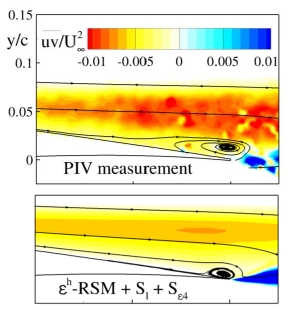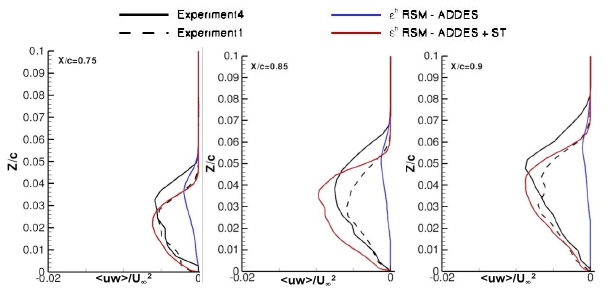In the sub-project B1 "Numerical simulation of engine inlet stall at low speed range with Reynolds stress turbulence models", works are carried out so as to improve the computations of massively detached flows based on hybrid RANS-LES with Reynolds Stress Models (RSM) as RANS model.
During the first funding phase of the research group the Low-Reynolds-number formulation of the RSM in its basic formulation was found to be unreliable in the calculation of transition to turbulence. Therefore, a physically-based transition trip was developed, where the transition point was determined on the eN- method. In addition, two new terms in the length scale equation based on the turbulence dissipation rate εh were defined to sensitize it to adverse pressure gradient and to avoid the excessive growth of the turbulence length scale in complex non-equilibrium flows.
These implementations considerably enhanced the transition prediction, prediction of the boundary layer profiles and the skin friction. Hence a reliable RSM model resulted, which provides good representations of boundary layers approaching separated flow. But, despite these improvements, the new RSM showed some weakness when applied to strong separations at airfoil trailing edges or inlet, often providing an underestimated size of the separation (Figure 1) or a too low level of modelled turbulence within the flow separation.

As the ultimate aim is to accurately compute strongly detached flows, works moved forward to the Detached-Eddy Simulation (DES) approaches with the RSM as background model.
Thus, various DES approaches were implemented into the TAU-Code. These were tested for a flow with geometrically fixed separation, the backward facing step, and pressure induced separation of the HGR-01 airfoil at stall condition. Among the DES approaches was the Improved Delayed DES (IDDES), which extends the Delayed DES (DDES) by the additional capability of a wall-modelled LES.
The computations with the HGR-01airfoil at stall flow conditions, revealed a further problem of the implemented DES versions. The sensors for the detection of the LES regions did not react properly to a pressure-induced trailing edge separation, delaying the switch to the LES mode and thus suppressing the formation of resolved turbulence in this area (Figure 2: left) .

In order to overcome this shortcoming, a new version of DDES was implemented by the project partners from DLR, which uses algebraic sensors based on integral boundary layer quantities to perform the switch between RANS and LES. This is named ADDES. Figure 2 illustrates the delay function fd over the HGR-01 airfoil when run with DDES and ADDES. This function is used to discriminate between RANS and LES regions. It turns out that the ADDES model considerably improved the detection of the separation onset and provides an accurate switch from RANS to LES domain.
The implementation of the algebraic sensors solves the problem of accurately switching between RANS and LES mode, but still the problem of the long adaptation distance required in order to develop a physical turbulence content remained.
To solve this severe problem, a synthetic turbulence (ST) generator based on a spectral approach was introduced into the TAU-Code. The formulation reproduces accurately the Reynolds stress tensor provided by the RANS solution just before the RANS/LES interface and it provides suited time and space correlation information to the ST.
Figure 3 displays shear stress distributions obtained at the trailing edge of the HGR-01 airfoil. Very promising results are obtained when the synthetic turbulence is applied. Not only turbulent content is resolved in the LES domain of the airfoil trailing edge where the pure ADDES w/o ST did not show significant levels of turbulence, but also good agreement is obtained between the experimental and numerical results with respect to Reynolds shear stresses, mean flow data and overall lift coefficient.

The three-dimensional turbulent flow structures close to the airfoil trailing edge are seen in Figure 4. These structures rapidly develop within the small range where the synthetic turbulence is added.
